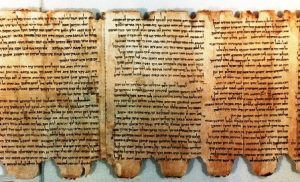Liturgy of the Qumran Sect, Lawrence H. Schiffman, Reclaiming the Dead Sea Scrolls, Jewish Publication Society, Philadelphia 1994.
[I will praise Him] at the times which He has ordained-
At the beginning of the rule of light in its time,
and when it is gathered to its appointed place.
At the beginning of the watches of darkness,
when He opens His storehouse and sets out the darkness,
and at its end when it is gathered before the light.
When the lights appear from the holy heaven,
when they are gathered to the place of honor.
This text refers to prayers for the morning and the evening. Based on this passage, one theory maintains that the sect prayed three times each day and three times each evening. But it seems more likely that the series of synonymous lines in the poem is simply imitating the ancient Hebrew poetic form of parallelism, whereby the same ideas are repeated for effect. If so, this text, like the Daily Prayers found among the cave 4 texts, would require prayer each morning and afternoon, at times corresponding to the required sacrifices of the Temple ritual.
The poem then lists various special occasions that require additional prayers (Rule of the Community 10-3–8)-
When the seasons begin on the days of the New Moon,
when together at their end they succeed one another….
At the beginnings of the months in their appointed times,
and holy days at the times appointed for their remembrance….
At the beginnings of the years and the times of their Festivals….
It is difficult to ferret out the allusions in this poem and in the verses that follow. Yet from other sources we know that the sectarians observed a complex ritual calendar, which included not only the Festivals required in the Torah—the New Year, Day of Atonement, Sukkot, Passover, Shavuot, and the New Month days—but also some additional holy days such as the extra harvest Festivals mentioned in some texts, mostly in the Temple Scroll. This poem makes clear that there were special prayers for these occasions.
Central to the liturgy of later Judaism is the proclamation of Jewish faith, Shema Yisrael- “Hear, O Israel, the Lord our God, the Lord is One” (Deuteronomy 6-4). The term “Shema” has come to designate a complex of biblical passages (Deuteronomy 6-4–9, 11-13–21; Numbers 15-37–41) recited according to Jewish tradition morning and evening. According to the Mishnah, this prayer was already central in Second Temple times (M. Tamid 5-1). We can identify allusions to the reading of the Shema in the poem at the end of Rule of the Community (10-10)-
With the entry of day and night I will enter the covenant of God,
and at the exit of evening and morning I will speak of His laws.
The expressions “enter the covenant of God” and “speak of His laws” are direct allusions to the major theme of the Shema- the confirmation of the Jew’s covenant with God and the requirement to speak of His commandments.
A number of expressions from elsewhere in this poem are suggestive of the language of the Amidah prayer. The Amidah (literally, “standing” prayer) is the core of the service in rabbinic Judaism. Because it originally contained eighteen benedictions, it is also known as the Shemoneh Esreh (eighteen). Talmudic traditions maintain that this prayer was authored in the time of Ezra and the Men of the Great Assembly, a body of sages said to have functioned from the fifth through the third centuries B.C.E. Because we have no direct evidence that the text of this prayer existed during the Qumran period, it is quite interesting to find in the scrolls parallels to its language, although we cannot conclude from such evidence that the prayer as we know it was recited by the sectarians.
Pages 292-293
What do you want to know?
Ask our AI widget and get answers from this website
